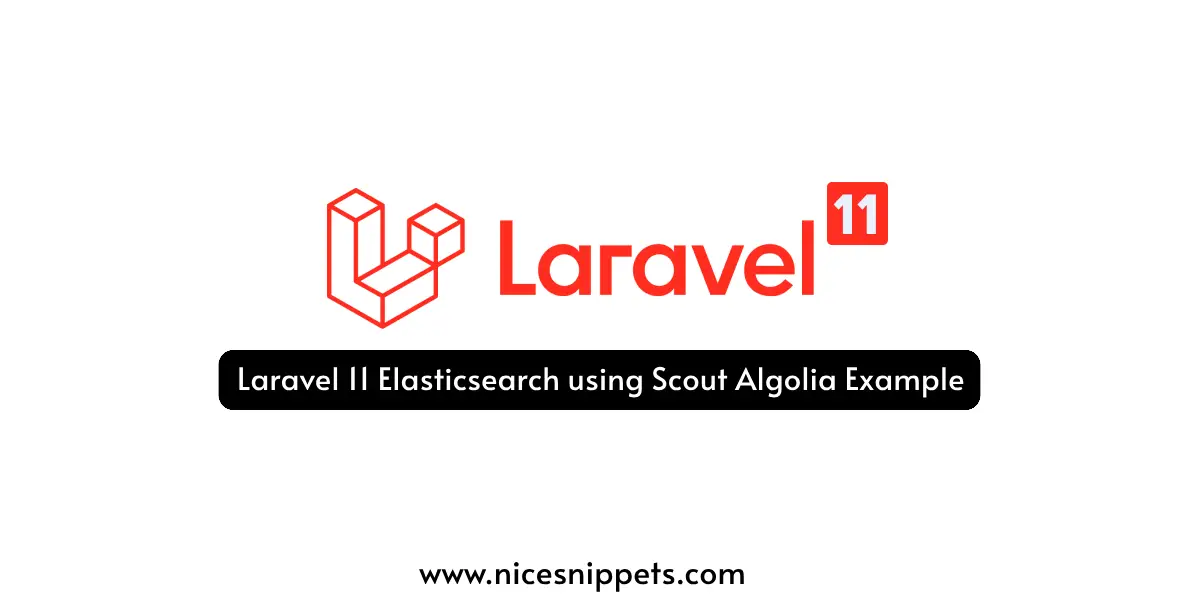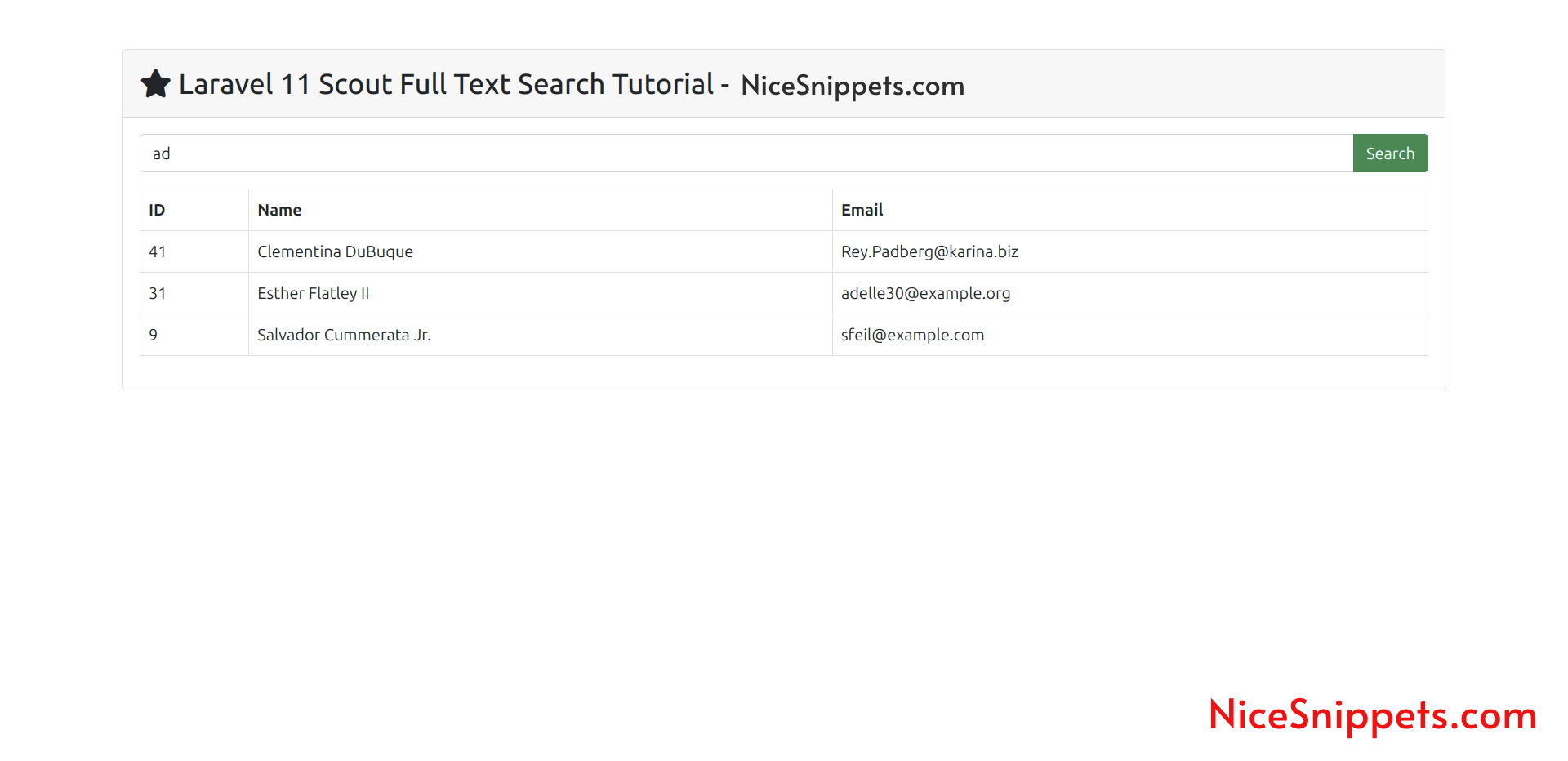05-Apr-2024
.
Admin

Helloo Dev,
In this guide, I'll demonstrate how to implement full-text search using Laravel 11's Scout package with Elasticsearch and the Algolia driver.
Laravel 11 introduces the Scout Package, offering robust full-text search capabilities for your project. With Scout, you have a choice of drivers including Algolia, Meilisearch, and Typesense. If you're aiming to integrate full-text search functionality into your Laravel 11 application, Scout is the ideal solution.
In this tutorial, we'll focus on installing the Scout Composer package and utilizing the database driver for full-text search. We'll then integrate Scout with the User model, enabling us to search through attributes such as name, email, and id. Let's dive into the steps below to implement this full-text search functionality effectively.
Following Step by Step for Full-Text Search Using Scout in Laravel 11
Step 1: Install Laravel 11
Step 2: Install Scout and Algolia Driver
Step 3: Update User Model
Step 4: Create UserController Controller
Step 5: Add Route
Step 6: Create View
Run Laravel App
Follow the below steps:
Step 1: Install Laravel 11
This step is not required; however, if you have not created the Laravel app, then you may go ahead and execute the below command:
composer create-project laravel/laravel example-app
Step 2: Install Scout and Algolia Driver
In this step, we have to install the Scout package and then publish them.
composer require laravel/scout
Next, we have to publish our configuration file, so you need to run the below command:
php artisan vendor:publish --provider="Laravel\Scout\ScoutServiceProvider"
Now we need to set the configuration database as the driver in your .env file.
.env
SCOUT_DRIVER=database
next, we need to install algolia composer package for driver. so, let's run the below code:
composer require algolia/algoliasearch-client-php
Step 3: Update User Model
Here, we already have a users table created, so we need to use "Searchable" and create the toSearchableArray() method. So let's update the following code:
app/Models/User.php
<?php
namespace App\Models;
use Illuminate\Database\Eloquent\Factories\HasFactory;
use Illuminate\Foundation\Auth\User as Authenticatable;
use Illuminate\Notifications\Notifiable;
use Laravel\Scout\Searchable;
class User extends Authenticatable
{
use HasFactory, Notifiable, Searchable;
/**
* The attributes that are mass assignable.
*
* @var array
*/
protected $fillable = [
'name',
'email',
'password',
];
/**
* The attributes that should be hidden for serialization.
*
* @var array
*/
protected $hidden = [
'password',
'remember_token',
];
/**
* Get the attributes that should be cast.
*
* @return array
*/
protected function casts(): array
{
return [
'email_verified_at' => 'datetime',
'password' => 'hashed',
];
}
/**
* Get the indexable data array for the model.
*
* @return array
*/
public function toSearchableArray()
{
return [
'name' => $this->name,
'email' => $this->email
];
}
}
Next, we will create some dummy records in the users table and import them. So let's run the following commands:
Create Dummy Records:
php artisan tinker
User::factory()->count(20)->create()
Import Records:
php artisan scout:import "App\Models\User"
Step 4: Create UserController Controller
At this point, we should create a new controller named UserController. In this controller, we will add an index method that will return users with a filter.
Let's update the following code in your controller file:
app/Http/Controllers/UserController.php
<?php
namespace App\Http\Controllers;
use Illuminate\Http\Request;
use App\Models\User;
use Illuminate\View\View;
class UserController extends Controller
{
/**
* Display a listing of the resource.
*
* @return \Illuminate\Http\Response
*/
public function index(Request $request): View
{
$users = User::search($request->search ?? '')->get();
return view('users', compact('users'));
}
}
Step 5: Add Route
In this step, we need to create a route for listing users. So, open your "routes/web.php" file and add the following route.
routes/web.php
<?php
use Illuminate\Support\Facades\Route;
use App\Http\Controllers\UserController;
Route::get('users', [UserController::class, 'index']);
Step 6: Create View
In the last step, let's create `users.blade.php` (`resources/views/users.blade.php`) for layout, and we will write design code here and put the following code:
resources/views/users.blade.php
<!DOCTYPE html>
<html>
<head>
<title>Laravel 11 Elasticsearch using Scout Algolia Example - NiceSnippets.com</title>
<link href="https://cdn.jsdelivr.net/npm/bootstrap@5.0.2/dist/css/bootstrap.min.css" rel="stylesheet" crossorigin="anonymous">
<link rel="stylesheet" href="https://cdnjs.cloudflare.com/ajax/libs/font-awesome/6.5.1/css/all.min.css" />
</head>
<body>
<div class="container">
<div class="card mt-5">
<h3 class="card-header p-3"><i class="fa fa-star"></i> Laravel 11 Elasticsearch using Scout Algolia Example - NiceSnippets.com</h3>
<div class="card-body">
<form method="GET">
<div class="input-group mb-3">
<input
type="text"
name="search"
value="{{ request()->get('search') }}"
class="form-control"
placeholder="Search..."
aria-label="Search"
aria-describedby="button-addon2">
<button class="btn btn-success" type="submit" id="button-addon2">Search</button>
</div>
</form>
<table class="table table-bordered mt-3">
<tr>
<th>ID</th>
<th>Name</th>
<th>Email</th>
</tr>
@foreach($users as $user)
<tr>
<td>{{ $user->id }}</td>
<td>{{ $user->name }}</td>
<td>{{ $user->email }}</td>
</tr>
@endforeach
</table>
</div>
</div>
</div>
</body>
</html>
Run Laravel App:
All the required steps have been done, now you have to type the given below command and hit enter to run the Laravel app:
php artisan serve
Now, Go to your web browser, type the given URL and view the app output:
http://localhost:8000/users
Output:

Maybe it can help you.....
#Laravel 11